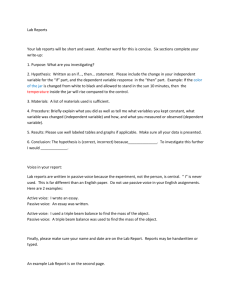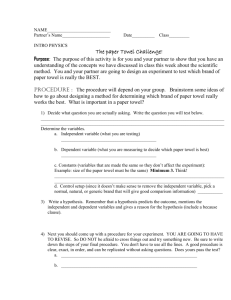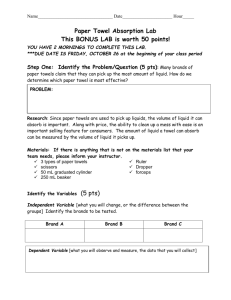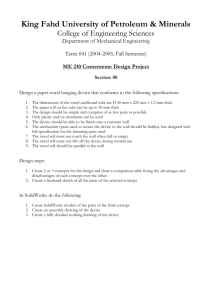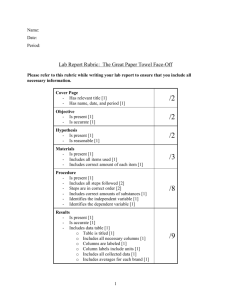B. Dependent Variable
advertisement
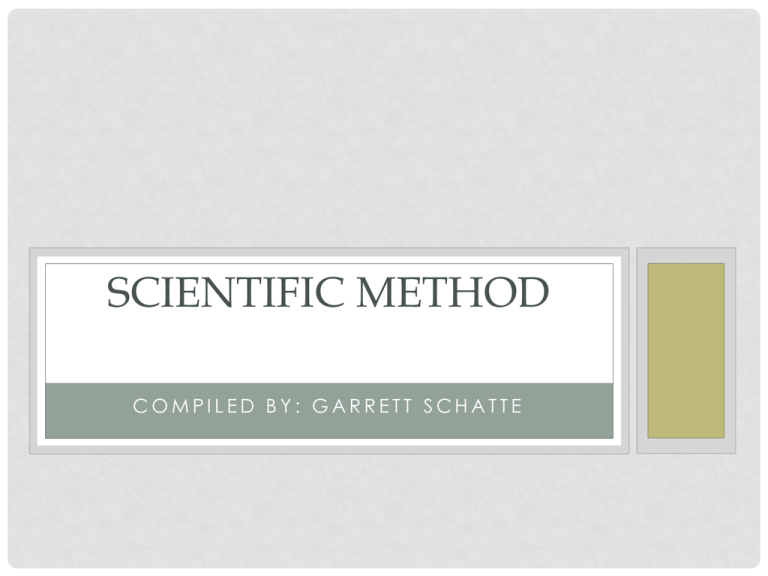
SCIENTIFIC METHOD COMPILED BY: GARRETT SCHATTE OBJECTIVES • • • • 1. 2. 3. 4. Develop a hypothesis Develop an experiment to test a hypothesis Collect data Make measurements SCIENTIFIC METHOD 1. Statement of Purpose or Question: [What do you want to know?] 2. Hypothesis: [What do you predict, in the form of an If…, then statement] SCIENTIFIC METHOD (CONT.) 3. Variables: A. Independent Variable [Factor being manipulated] B. Dependent Variable [Factor Which Responds - the one you measure] C. Constants or Controls held constant] [Factors that are SCIENTIFIC METHOD (CONT.) 4. Standards of Comparison: [Experimental Control] 5. Materials and Procedure: A. Materials: [List everything used to complete the experiment] B. Procedures [Step by step Directions - number each step like a recipe] SCIENTIFIC METHOD (CONT.) 6. Qualitative Observations & Results: [List things that could have been done incorrectly, and write them down during the experimentation.] 7. Quantitative Results: A. Raw Data [Record in a table] B. Results [Display data using graphs. Averages or Line of Best-Fit] SCIENTIFIC METHOD (CONT.) 8. Analysis & Interpretation of Results: [Describe in words the results] 9. Possible Experimental Errors: [Give an explanation for each factor noted in step 6 that could have had an affect on the experiment] 10. Conclusion: [Include why your results did, or did not, support the Hypothesis] 11. Recommendations for further experimentation based on your data & practical applications: TEACHING EXAMPLES OF THE SCIENTIFIC METHOD THE PAPER TOWEL WITH GREAT HOLDING POWER 1. Statement of Purpose or Question: Which paper towel will hold the most water? 2. Hypothesis: When Brawny, Scott and a store brand are tested for absorbency, then … will be proven to hold the most water. 3. Variables: A. Independent Variable Brand of paper towel B. Dependent Variable Brand of paper towel C. Constants or Controls Amounts of water added to paper towel Size of the paper towel Process of determining amount of water left Time water is on paper towel Test all three brands around the same time and on the same day 4. Standards of Comparison: Color and size of each brand of paper towel 5. Materials and Procedure : A. Materials roll of Brawny, Scott & store brand Graduated cylinder calculator extra paper towels water scissors pan ruler B. Procedures: 1. 2. 3. 4. 5. 6. 7. 8. 9. Get all materials. Review my directions for experiment. Cut paper towels into 4 cm x 4 cm squares. Lay one square of Bounty paper towel in the e pan. Measure out 10 ml of water and add to paper towel in pan. Let it set for one for one minute. Pick up paper towel with forceps and let the extra water drip out of paper towel until the drops are at least five seconds apart. Pour water in cake pan back into the graduated cylinder and calculate the amount of water the square of paper to held. Repeat steps 5-9 for each paper towel for total of fifty times. 6. QUALITATIVE OBSERVATIONS: Some water was lost when it was returned to the graduated cylinder. Water temperature was hard regulate. During some test the air conditioner was on. 7. Quantitative Results: A. Raw Data Paper Towel Brand Table 1 2 3 4 5 Class Avg. Brawny Scott Store B. Results Paper Towel with Greatest Holding Power 10 Average Amount of Water Held in mL 9 8 7 6 5 4 3 2 1 0 Brawny Scott Store 8. Analysis & Interpretation of Results: [In words describe what was discovered.] 9. Possible Experimental Errors: [Review step 6 and write statements of what you observed.] 10.Conclusion: [State whether your hypothesis was correct and Include why your results did, or did not, support the Hypothesis] 11. Recommendations for further experimentation based on your data & practical applications:
